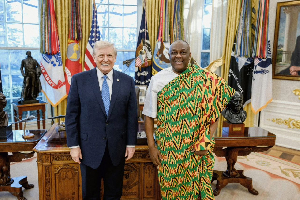By Joe Kingsley Eyiah, OCT, Brookview Middle School, Toronto-Canada
“Understanding and knowing how to do mathematics makes our day-to-day lives easier. Understanding and using mathematics to make decisions and to take action builds confidence and joy!’
I have been prompted to revisit the issue of the teaching and learning of Mathematics in schools due to reports of poor performance in the Ontario provincial math standard test and the concerns raised over the results of Basic Education Certificate Examination in Ghana this year. According to news reports in Toronto, “Half of all Grade 6 students in Ontario did not meet the provincial math standard this year. Standardized test results for elementary school students released by the Province’s Education Quality and Accountability Office (EQAO) shows that while reading results are improving math results are getting worse.” Why? Is it lack of love for Math by students, their teachers and their parents?
Technology in the teaching of Math as a subject in our schools has become very essential in today’s world. Children are easily attracted to computers and other technological devices which provide games. Such devices when appropriately guided and directed (supervised) by a trained teacher, are very effective tools for learning. They become useful tools for facilitating learning in the classroom. They make learning fun! However, the learning of Mathematics is no fun to many students. Ask many students from Ghana to Canada and across the world and about seventy percent of students surveyed would tell you that ‘they hate Mathematics as a subject!’ Why? Even among teachers, you would one say, “Math was not my favorite subject at school. When I was a student I love Math and as a teacher, I love to teach Math.
What is Math?
Math is the most misunderstood subject. Research confirms that for more than two thousand years, mathematics has been a part of the human search for understanding. Most discoveries have been promoted by the study of mathematics. Science has been driven by Math. Think of the Pythagoras, the Galileo and the Archimedes! Mathematics is not about answers, it's about processes. How do we arrive at that answer? Which steps are followed? Are there other ways by which we can arrive at the same answer? So Math is more of problem solving. However, how do students actively engage in bringing about their own understanding if they are not interested in what they are asked to do?
Why is it important for our Children to Learn Mathematics?
Research has shown that math knowledge and skills contribute to a child’s success both at school and in everyday life. If you want to build your child’s confidence in problem solving then help him or her to learn mathematics. It must be noted that skills in math open doors to a range of jobs and careers. Nowadays, schools are combining the study of math with science, technology and engineering in an area of studies dubbed STEM. STEM leads the student to investigate, think outside the box, gather and organize information which is then used to solve problems
Love Math!
We do what we love doing, right? Loving Math is not just by chance. There may be some few children who are naturally gifted in Mathematics. At school, they score the highest marks in Math and even ‘teach’ their teachers how to do some Math. True! However, there are many children who we must encourage as parents and teachers to love Math. Math is everywhere. It is i.n the house, around the dinner table, in the streets, at church, in the stores/malls and in our favorite sports-money, time, distance, capacity, quantity, building, playing and so forth! We ought to arouse the interest of our children in these areas through our daily interactions with them.
Movement is common among children. Many children love to interact with their friends as we see when they are in the gym for physical education. One of the major problems I find among my students is the constant need to be moving – being active. Many of them have difficulty keeping focused; hence they require frequent change in their activities to sustain their attention. “Movement in drama offers students an opportunity to explore and express thoughts and feelings through physical action. It can serve to increase the student’s willingness to get involved in drama and to encourage interaction with other members of the group. Further, by allowing the students to work creatively and spontaneously, it can enhance the aesthetic learning experience”. (David Booth, Story Drama, p. 50) The students love Gym – Why? It is because Gym gives them an opportunity to move. How can we incorporate this same enthusiasm in other classes? Simple, by including that factor that makes Gym so exciting – movement. My students resent activities that restrict them to a desk with pen and paper most of the time. As teachers, we need to ‘dramatize’ Math in the classroom or engage our students more in group-work during their Math lessons.
Personally, I think we need to catch our children young with Math. We have to create or use ‘interest’ to make children learn Math. The technological devices are useful but the basics are very fundamental to teaching even problem solving in Math. The more we practice Math with our children in our daily activities, the more we create interest in them (extrinsic) to love Math. Make Math fun, bring Math home to the child to engage him or her to create his or her understanding of Math. As parents and teachers, we need to give the basics in Math to our children through constant practice and provide them tools to solve problems. Then, they would be discovering Math for themselves. Then, they would love Math as a subject. If you need help to assist your child in learning Math, do not hesitate to do that. Ask and you will be given; seek and you will find (from the computer to the Math teacher). A deeper understanding of mathematics will enable you to let your children explore Math.
As a parent there are many mathematics activities you can do with your child in the strands of number sense and numeration, measurement, geometry and spatial sense, patterning and algebra, as well as data management and probability. For example, numbers are everywhere. You can count with your child number of objects in house and group them like “there are 3 tables and 12 chairs in the house.” Then ask your child to tell how many tables and chairs are there together in the house and also say which of the two objects is more in numbers and, by how many counts? The child will be counting and learning addition and subtraction of numbers which are basic to doing mathematics.
There are some internet resources which are helpful for learning math at home. Parents must review such websites and determine their suitability for their children (age and grade):
www.brainpop.com/math/seeall/
www.kidsites.com/sites-edu/math.htm
Opinions of Sunday, 2 October 2016
Columnist: Eyiah, Joe Kingsley
Helping Our Children Do Mathematics
Opinions













